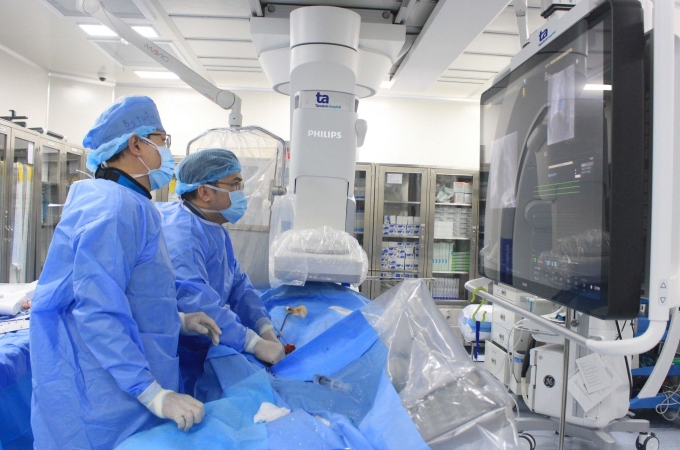Ms. Phuong (26 years old) went for a general health check-up and accidentally discovered a 20 mm atrial septal defect even though she had never had any symptoms before.
After one day of intervention to close the atrial septal defect, Ms. Le Truc Phuong ( Khanh Hoa ) returned to normal activities and was discharged from the hospital.
On May 26, Dr. Vu Nang Phuc, Head of the Congenital Heart Department, Cardiovascular Center, Tam Anh General Hospital, Ho Chi Minh City, said that when examining Ms. Phuong, the doctor heard an abnormal heart murmur, suspecting a cardiovascular disease, so he advised further clinical examination. The echocardiogram results showed an atrial septal defect, with the largest diameter being 20 mm. This is a typical case of congenital heart disease in adults, detected late due to the silent progression of the disease.
Average hole size. However, if the atrial septal defect is not closed, it can lead to heart failure, arrhythmia, and reduced quality of life. Some rare cases can be accompanied by lung disease, pulmonary blood vessels leading to pulmonary hypertension, causing permanent damage to the heart and lungs.
The results of the transesophageal echocardiogram showed that the distance from the hole to the surrounding structures was adequate. Therefore, the doctor chose the minimally invasive intervention method of closing the atrial septal defect with a device (umbrella).

Dr. Vu Nang Phuc (second from left) and Dr. Luong Minh Thong perform a procedure to close a hole in the patient's heart. Photo: Tam Anh Hospital
The patient was given local anesthesia in the groin area and was awake during the procedure. Dr. Phuc inserted a guidewire through the femoral vein to create a pathway to the heart. Next, the team measured pulmonary artery pressure to avoid pulmonary hypertension. The patient's average pulmonary artery pressure was 13mmHg, safe for the procedure.
To perform the procedure, choosing the right size of parachute to close the atrial septal defect is the key to success. Combining transesophageal echocardiography and cardiac catheterization, the doctor accurately measured the size of the defect to be 24 mm. The team used a parachute made of nitinol alloy, forming 2 self-expanding mesh discs, 26 mm in size, to close the defect.
During the procedure, all movements are gentle, avoiding damage to nearby organs. Before completing the procedure, Dr. Phuc performs an echocardiogram to ensure that the instrument is placed in the correct position, not pressing on nearby organs, causing heart valve leakage.

The doctor performed a transthoracic echocardiogram after the procedure to ensure that the parachute was sealing the hole and did not pop open. Photo: Tam Anh Hospital
Most cases of congenital heart disease are detected in the fetus or after birth. For patients who do not show symptoms and are not screened after birth, the disease will silently progress until adulthood. Some common congenital heart diseases in adults include: atrial septal defect or small shunts, congenital heart disease that has been completely surgically removed, complex congenital heart disease that is too surgically indicated, etc.
Thu Ha
* Patient name has been changed.
Source link


![[Photo] Scientific workshop "Building a socialist model associated with socialist people in Hai Phong city in the period of 2025-2030 and the following years"](https://vphoto.vietnam.vn/thumb/1200x675/vietnam/resource/IMAGE/2025/5/21/5098e06c813243b1bf5670f9dc20ad0a)

![[Photo] Prime Minister Pham Minh Chinh receives the President of Asia-Pacific region of PowerChina Group](https://vphoto.vietnam.vn/thumb/1200x675/vietnam/resource/IMAGE/2025/5/21/0f4f3c2f997b4fdaa44b60aaac103d91)
![[Photo] Prime Minister Pham Minh Chinh receives Rabbi Yoav Ben Tzur, Israeli Minister of Labor](https://vphoto.vietnam.vn/thumb/1200x675/vietnam/resource/IMAGE/2025/5/21/511bf6664512413ca5a275cbf3fb2f65)

![[Photo] Coming to Son La, let's "show off" with the Wallflowers](https://vphoto.vietnam.vn/thumb/1200x675/vietnam/resource/IMAGE/2025/5/21/627a654c41fc4e1a95f3e1c353d0426d)

























































































Comment (0)